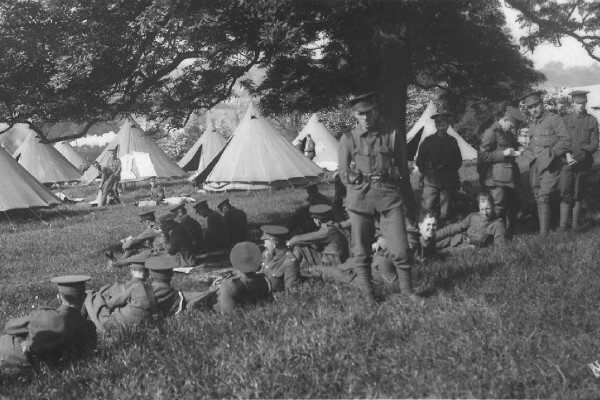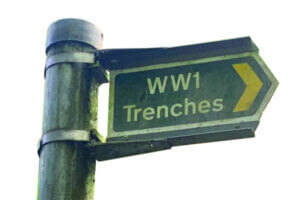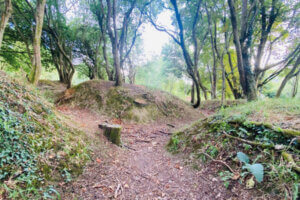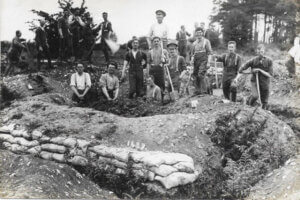Trained by The Devil’s Own

Thousands of young men took part in wartime training on Berkhamsted and Northchurch Commons before they were shipped to the Front.
 The beautiful Chilterns countryside around us provides a wonderful place to walk, especially in the autumn months, but there is one part of the land near Berkhamsted that still bears the scars of the
The beautiful Chilterns countryside around us provides a wonderful place to walk, especially in the autumn months, but there is one part of the land near Berkhamsted that still bears the scars of the
First World War.
This area of Outstanding Natural Beauty and protected Green Belt land leads to Berkhamsted Common. There is a rich history here – not least the battle of Berkhamsted Common, which we mentioned in a previous issue – but here we look at a more recent part of our area’s past.
 You may have walked across the area and wondered about the dips and troughs across the land – and if you happened across an information board, you’ll know that these were, in fact, trenches dug by young men destined to be shipped out to the Western Front.
You may have walked across the area and wondered about the dips and troughs across the land – and if you happened across an information board, you’ll know that these were, in fact, trenches dug by young men destined to be shipped out to the Western Front.
The training camp saw thousands of young soldiers pass through, housed in a tented camp situated in the Bridgewater Road area. From 1914 until 1919, this was where the Inns of Court Officers Training Corps (nicknamed The Devil’s Own) was based.
The Inns of Court Officers Training Corps (OTC) was a Territorial Army unit based in Chancery Lane in London, near the headquarters of the Law Society of England and Wales and next to Lincoln’s Inn. It was closely associated with the legal profession, and its cap badge included the arms of the four Inns of Court.
Once war broke out, its numbers expanded quickly, and it outgrew its London premises, and made its way to Berkhamsted.
 A total of around 12,000 young soldiers spent months here in training, before they were allocated a place in a battalion and sent off to fight. Part of their training involved digging trenches, in preparation for the real thing in Europe. The clay and flint would have made for a hard task, but would have prepared the young men for the similar conditions they would encounter overseas.
A total of around 12,000 young soldiers spent months here in training, before they were allocated a place in a battalion and sent off to fight. Part of their training involved digging trenches, in preparation for the real thing in Europe. The clay and flint would have made for a hard task, but would have prepared the young men for the similar conditions they would encounter overseas.
In the official history of the Corps [E.R.L. Errington, The Inns of Court Officers Training Corp during the Great War] it describes how they worked the young recruits hard, occasionally to the alarm of the locals: ‘For the squadron, long treks without touching a road, wide movements, distant reconnaissance; for the infantry, wood fighting, canal crossings, river crossings, big fights on the open commons and downs, local fighting among the enclosures, every form of open training was available. In the neighbouring villages, Nettleden, Little Gaddesden, Aldbury, Ashley Green, Bovingdon, the awakened villager turned to sleep again with greater security when he realised that the outburst of firing, and the swift rush of feet through the village street, betokened nothing more than a night raid of the Devil’s Own…’
They also took part in drills and other practice – much of it taking place on what is now called Kitchener’s Field.
When the OTC finally left Berkhamsted ‘The whole Battalion was at the Station, and many of our good friends, the inhabitants of Berkhamsted, not a few of whom (among the young and fair) were observed to dash a tell-tale tear from downcast eye.’
Officers paid tribute to the town’s locals and mentioned Mr George Blincow, ‘the helpful Stationmaster’. George’s grave is in Rectory Lane Cemetery and you can read more about him on its excellent website at www.rectorylanecemetery.org.uk.
At the junction of New Road and Potten End Road, at Berkhamsted Golf Course, is a stone obelisk dedicated to the memory of those men of the training corps who died during the war. About 5,000 of the men who trained at Berkhamsted, were wounded, and nealy 2,200 were killed.
After the war a lot of the trench system was filled in and the rest became overgrown, but in 2013, a seven-month restoration project took place, which involved clearing away scrub and vegetation from the remaining trenches. It was carried out by 35 volunteers from the Chilterns Conservation Board and the Chiltern Society.
The trenches also made their way into literature, thanks to Berkhamsted author Graham Green, who mentions them in his 1978 novel The Human Factor. The book’s hero, Castle, remembers that it was unsafe to walk in the area ‘since the old trenches had been dug several feet deep…a stranger risked
a sudden fall and a broken leg.’
With thanks to Richard North and Berhamsted Museum and Historical Society

